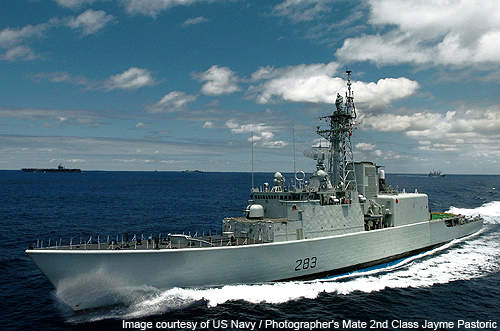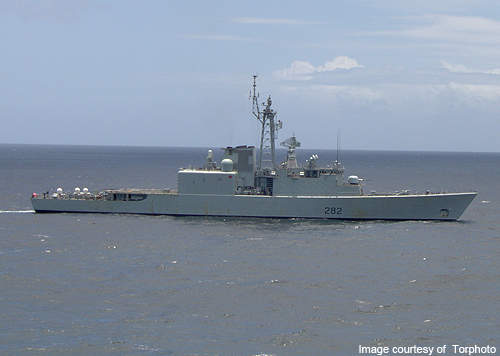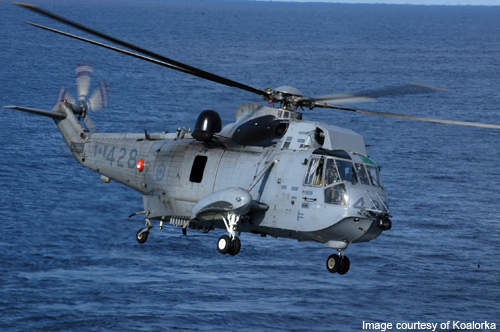The Iroquois Class air defence destroyers were built by Marine Industries and Davie Shipbuilding for the Canadian Navy. The warships are also known as Tribal Class destroyers. Originally built as anti-submarine warfare destroyers in the 1970s, these ships were modified as area air defence destroyers through a major upgrade programme in the 1990s.
Three ships are currently in service with the Canadian Forces Maritime Command, while one ship was decommissioned in March 2005.
The keel for the lead destroyer in class, HMCS Iroquois (DDH 280), was laid down in January 1969. It was launched in November 1970 and commissioned in July 1972. HMCS Huron (DDH 281) was laid down in June 1969, launched in April 1971 and commissioned in December 1972. It was decommissioned in March 2005.
HMCS Athabaskan (DDH 282) was laid in June 1969, launched in November 1970 and commissioned in November 1972.
The last vessel in class, HMCS Algonquin (DDG 283), was laid down in September 1969. It was launched in April 1971 and commissioned in November 1972.
Iroquois Class destroyer design
Originally built for long-range anti-submarine warfare, the destroyers are designed to carry two CH-124 Sea King helicopters. About half of the space is allocated for a helicopter platform. There is a hangar for helicopters.
The destroyers are also fitted with two triple-mount torpedo launchers to complement the helicopters.
The other weapon systems fitted are Otobreda 127/54 Compact 5in multi-purpose gun and two Sea Sparrow launchers. The ships are powered by two Pratt & Whitney FT12-AH3 gas turbines complemented by two FT4-A2 gas turbines. The design also includes Y-shaped funnels.
Iroquois Class modifications
The Athabaskan was modified at CFB Halifax in August 1990 before its deployment in Operation Friction, Operation Desert Shield and Operation Desert Storm (the Gulf War). These modifications added mine-avoidance sonar, a Phalanx 20mm close-in weapon system and shoulder launched Blowpipe and Javelin missiles.
The entire class was modified for air defence roles as a part of the Tribal Class Update and Modernization Project (TRUMP) in the early 1990s.
The new weapons included were the Mk.41 VLS for SM-2 Block III long-range anti-aircraft missiles. The original 5in gun was replaced with the Oto Melara 76mm gun and a Phalanx CIWS was added for point-defence. The Sea Sparrow launchers were removed.
The Pratt & Whitney FT-12 cruise turbines were replaced with Allison 570-KF engines. The new engine configuration had increased the full load displacement to 5,100t. The original split funnel was replaced by a single type funnel.
Command and control
The ship is equipped with advanced electronic systems and a computer-driven command and control system.
The system collects data from the ship’s sensors, other surface fleet units, aircraft and satellites and displays real-time info and imagery for the operators.
Weapon systems
The Iroquois Class is armed with a Martin Marietta MK 41 vertical launch system (VLS) firing 29 Standard SM2 Block IIIA surface-to-air missiles.
The main gun fitted forward is an OTO Melara 76mm (3in) super rapid gun.
A 20mm six-barrelled Vulcan Phalanx gatling gun installed in the ship can fire up to 3,500 rounds per minute.
There are two 324mm MK 32 triple tubes fitted for MK46 active / passive homing torpedoes.
Iroquois helicopter system
The Iroquois Class has a helicopter deck and hangar space to allow the operations of two twin engine CH 124 Sea King medium range helicopters.
These helicopters are equipped with variable depth sonar, radar and two MK 46 anti-submarine torpedoes. The helicopters can detect and track vessels and submarines at long ranges.
Sensors / radars
The destroyer is equipped with AN/SPQ 501 DA-08 radar and LW-08 AN/SPQ 502 radar from Signal (know Thales Netherland). The sonars include SQS-510 hull mounted sonar and SQS-510 variable depth sonar (VDS).
Propulsion
The Iroquois Class is powered by a two shaft combined gas or gas (COGOG) system.
The propulsion system includes two Pratt & Whitney FT4A2 boost gas turbines of 50,000shp and two GM Allison 570KF cruise gas turbines of 12,800shp.
These engines drive two five-bladed variable reversible pitch propellers. The propulsion system provides a maximum speed of over 29kt and a maximum range of 4,500 miles at 20kt speed.













